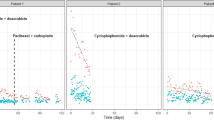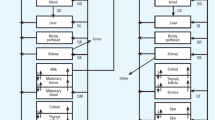ABSTRACT
Purpose
Drug transfer into milk is of concern due to the unnecessary exposure of infants to drugs. Proposed prediction methods for such transfer assume only passive drug diffusion across the mammary epithelium. This study reorganized data from the literature to assess the contribution of carrier-mediated transport to drug transfer into milk, and to improve the predictability thereof.
Methods
Milk-to-plasma drug concentration ratios (M/Ps) in humans were exhaustively collected from the literature and converted into observed unbound concentration ratios (M/Punbound,obs). The ratios were also predicted based on passive diffusion across the mammary epithelium (M/Punbound,pred). An in vitro transport assay was performed for selected drugs in breast cancer resistance protein (BCRP)-expressing cell monolayers.
Results
M/Punbound,obs and M/Punbound,pred values were compared for 166 drugs. M/Punbound,obs values were 1.5 times or more higher than M/Punbound,pred values for as many as 13 out of 16 known BCRP substrates, reconfirming BCRP as the predominant transporter contributing to secretory transfer of drugs into milk. Predictability of M/P values for selected BCRP substrates and non-substrates was improved by considering in vitro-evaluated BCRP-mediated transport relative to passive diffusion alone.
Conclusions
The current analysis improved the predictability of drug transfer into milk, particularly for BCRP substrates, based on an exhaustive data overhaul followed by focused in vitro transport experimentation.



Similar content being viewed by others
Abbreviations
- ABCG2:
-
ATP-binding cassette transporter G2
- BCRP:
-
Breast cancer resistance protein
- CNT:
-
Concentrative nucleoside transporter
- f m,protein :
-
Fraction of drug free from binding to milk protein
- f m,total :
-
Unbound drug fraction in milk
- f p :
-
Unbound drug fraction in plasma
- GFP:
-
Green fluorescent protein
- HBSS:
-
Hank’s balanced salt solution
- LC-MS/MS:
-
Liquid chromatography-tandem mass spectroscopy
- logD 7.2 :
-
Octanol/water partition coefficient at pH 7.2
- M/P:
-
Milk-to-plasma concentration ratio
- M/P(AUC):
-
M/P area-under-the-curve ratio
- M/Punbound :
-
Unbound M/P
- M/Punbound,obs :
-
Observed unbound M/P
- M/Punbound,pred :
-
Predicted unbound M/P
- MDCK:
-
Madin-Darby canine kidney
- MEM:
-
Minimum Essential Medium
- OCT:
-
Organic cation transporter
- P app :
-
Partition coefficient between milk lipids and water
- PEPT:
-
Peptide transporter
- Robs/pred :
-
Ratio of M/Punbound,obs to M/Punbound,pred
- SEM:
-
Standard error of the mean
- SLC:
-
Solute carrier
- UPLC:
-
Ultra-performance liquid chromatography
REFERENCES
Flacking R, Ewald U, Starrin B. “I wanted to do a good job”: experiences of ‘becoming a mother’ and breastfeeding in mothers of very preterm infants after discharge from a neonatal unit. Soc Sci Med. 2007;64:2405–16.
Jones G, Steketee RW, Black RE, Bhutta ZA, Morris SS. How many child deaths can we prevent this year? Lancet. 2003;362:65–71.
Kramer MS. “Breast is best”: the evidence. Early Hum Dev. 2010;86:729–32.
Anderson PO. Drug use during breast-feeding. Clin Pharm. 1991;10:594–624.
Matheson I. Drugs taken by mothers in the puerperium. Br Med J (Clin Res Ed). 1985;290:1588–9.
Atkinson HC, Begg EJ. Prediction of drug distribution into human milk from physicochemical characteristics. Clin Pharmacokinet. 1990;18:151–67.
Begg EJ, Atkinson HC, Duffull SB. Prospective evaluation of a model for the prediction of milk: plasma drug concentrations from physicochemical characteristics. Br J Clin Pharmacol. 1992;33:501–5.
Fleishaker JC. Models and methods for predicting drug transfer into human milk. Adv Drug Deliv Rev. 2003;55:643–52.
Rasmussen F. Mammary excretion of benzylpenicillin, erythromycin, and penethamate hydroiodide. Acta Pharmacol Toxicol (Copenh). 1959;16:194–200.
Notarianni LJ, Belk D, Aird SA, Bennett PN. An in vitro technique for the rapid determination of drug entry into breast milk. Br J Clin Pharmacol. 1995;40:333–7.
Fleishaker JC, Desai N, McNamara PJ. Factors affecting the milk-to-plasma drug concentration ratio in lactating women: physical interactions with protein and fat. J Pharm Sci. 1987;76:189–93.
Gerk PM, Kuhn RJ, Desai NS, McNamara PJ. Active transport of nitrofurantoin into human milk. Pharmacotherapy. 2001;21:669–75.
Lau RJ, Emery MG, Galinsky RE. Unexpected accumulation of acyclovir in breast milk with estimation of infant exposure. Obstet Gynecol. 1987;69:468–71.
Oo CY, Kuhn RJ, Desai N, McNamara PJ. Active transport of cimetidine into human milk. Clin Pharmacol Ther. 1995;58:548–55.
Meskin MS, Lien EJ. QSAR analysis of drug excretion into human breast milk. J Clin Hosp Pharm. 1985;10:269–78.
Agatonovic-Kustrin S, Ling LH, Tham SY, Alany RG. Molecular descriptors that influence the amount of drugs transfer into human breast milk. J Pharm Biomed Anal. 2002;29:103–19.
Katritzky AR, Dobchev DA, Hur E, Fara DC, Karelson M. QSAR treatment of drugs transfer into human breast milk. Bioorg Med Chem. 2005;13:1623–32.
Zhao C, Zhang H, Zhang X, et al. Prediction of milk/plasma drug concentration (M/P) ratio using support vector machine (SVM) method. Pharm Res. 2006;23:41–8.
Dostal LA, Weaver RP, Schwetz BA. Excretion of high concentrations of cimetidine and ranitidine into rat milk and their effects on milk composition and mammary gland nucleic acid content. Toxicol Appl Pharmacol. 1990;102:430–42.
Gerk PM, Oo CY, Paxton EW, Moscow JA, McNamara PJ. Interactions between cimetidine, nitrofurantoin, and probenecid active transport into rat milk. J Pharmacol Exp Ther. 2001;296:175–80.
McNamara PJ, Burgio D, Yoo SD. Pharmacokinetics of cimetidine during lactation: species differences in cimetidine transport into rat and rabbit milk. J Pharmacol Exp Ther. 1992;261:918–23.
Jonker JW, Merino G, Musters S, et al. The breast cancer resistance protein BCRP (ABCG2) concentrates drugs and carcinogenic xenotoxins into milk. Nat Med. 2005;11:127–9.
Merino G, Jonker JW, Wagenaar E, van Herwaarden AE, Schinkel AH. The breast cancer resistance protein (BCRP/ABCG2) affects pharmacokinetics, hepatobiliary excretion, and milk secretion of the antibiotic nitrofurantoin. Mol Pharmacol. 2005;67:1758–64.
van Herwaarden AE, Schinkel AH. The function of breast cancer resistance protein in epithelial barriers, stem cells and milk secretion of drugs and xenotoxins. Trends Pharmacol Sci. 2006;27:10–6.
Ito N, Ito K, Ikebuchi Y, et al. Organic cation transporter/solute carrier family 22a is involved in drug transfer into milk in mice. J Pharm Sci. 2014;(in press).
Alcorn J, Lu X, Moscow JA, McNamara PJ. Transporter gene expression in lactating and nonlactating human mammary epithelial cells using real-time reverse transcription-polymerase chain reaction. J Pharmacol Exp Ther. 2002;303:487–96.
Farke C, Meyer HH, Bruckmaier RM, Albrecht C. Differential expression of ABC transporters and their regulatory genes during lactation and dry period in bovine mammary tissue. J Dairy Res. 2008;75:406–14.
Gilchrist SE, Alcorn J. Lactation stage-dependent expression of transporters in rat whole mammary gland and primary mammary epithelial organoids. Fundam Clin Pharmacol. 2010;24:205–14.
Groneberg DA, Doring F, Theis S, Nickolaus M, Fischer A, Daniel H. Peptide transport in the mammary gland: expression and distribution of PEPT2 mRNA and protein. Am J Physiol Endocrinol Metab. 2002;282:E1172–9.
Ito S, Alcorn J. Xenobiotic transporter expression and function in the human mammary gland. Adv Drug Deliv Rev. 2003;55:653–65.
Koshimichi H, Ito K, Hisaka A, Honma M, Suzuki H. Analysis and prediction of drug transfer into human milk taking into consideration secretion and reuptake clearances across the mammary epithelia. Drug Metab Dispos. 2011;39:2370–80.
Hale TW. Medications and mother’s milk. 13th ed. TX: Hale Publishing; 2008.
Ito N, Ito K, Koshimichi H, et al. Contribution of protein binding, lipid partitioning, and asymmetrical transport to drug transfer into milk in mouse versus human. Pharm Res. 2013;30:2410–22.
Atkinson HC, Begg EJ. Relationship between human milk lipid-ultrafiltrate and octanol-water partition coefficients. J Pharm Sci. 1988;77:796–8.
Kodaira H, Kusuhara H, Fujita T, Ushiki J, Fuse E, Sugiyama Y. Quantitative evaluation of the impact of active efflux by p-glycoprotein and breast cancer resistance protein at the blood–brain barrier on the predictability of the unbound concentrations of drugs in the brain using cerebrospinal fluid concentration as a surrogate. J Pharmacol Exp Ther. 2011;339:935–44.
Kondo C, Suzuki H, Itoda M, et al. Functional analysis of SNPs variants of BCRP/ABCG2. Pharm Res. 2004;21:1895–903.
Barrera B, Otero JA, Egido E, et al. The anthelmintic triclabendazole and its metabolites inhibit the membrane transporter ABCG2/BCRP. Antimicrob Agents Chemother. 2012;56:3535–43.
Pan G, Giri N, Elmquist WF. Abcg2/Bcrp1 mediates the polarized transport of antiretroviral nucleosides abacavir and zidovudine. Drug Metab Dispos. 2007;35:1165–73.
Wang X, Furukawa T, Nitanda T, et al. Breast cancer resistance protein (BCRP/ABCG2) induces cellular resistance to HIV-1 nucleoside reverse transcriptase inhibitors. Mol Pharmacol. 2003;63:65–72.
Hemauer SJ, Patrikeeva SL, Wang X, et al. Role of transporter-mediated efflux in the placental biodisposition of bupropion and its metabolite, OH-bupropion. Biochem Pharmacol. 2010;80:1080–6.
Marki-Zay J, Tauberne Jakab K, Szeremy P, Krajcsi P. MDR-ABC transporters: biomarkers in rheumatoid arthritis. Clin Exp Rheumatol. 2013;31:779–87.
Pavek P, Merino G, Wagenaar E, et al. Human breast cancer resistance protein: interactions with steroid drugs, hormones, the dietary carcinogen 2-amino-1-methyl-6-phenylimidazo(4,5-b)pyridine, and transport of cimetidine. J Pharmacol Exp Ther. 2005;312:144–52.
Merino G, Alvarez AI, Pulido MM, Molina AJ, Schinkel AH, Prieto JG. Breast cancer resistance protein (BCRP/ABCG2) transports fluoroquinolone antibiotics and affects their oral availability, pharmacokinetics, and milk secretion. Drug Metab Dispos. 2006;34:690–5.
Ando T, Kusuhara H, Merino G, Alvarez AI, Schinkel AH, Sugiyama Y. Involvement of breast cancer resistance protein (ABCG2) in the biliary excretion mechanism of fluoroquinolones. Drug Metab Dispos. 2007;35:1873–9.
Kato Y, Takahara S, Kato S, et al. Involvement of multidrug resistance-associated protein 2 (Abcc2) in molecular weight-dependent biliary excretion of beta-lactam antibiotics. Drug Metab Dispos. 2008;36:1088–96.
Gunness P, Aleksa K, Koren G. Acyclovir is a substrate for the human breast cancer resistance protein (BCRP/ABCG2): implications for renal tubular transport and acyclovir-induced nephrotoxicity. Can J Physiol Pharmacol. 2011;89:675–80.
Hasegawa M, Kusuhara H, Adachi M, Schuetz JD, Takeuchi K, Sugiyama Y. Multidrug resistance-associated protein 4 is involved in the urinary excretion of hydrochlorothiazide and furosemide. J Am Soc Nephrol. 2007;18:37–45.
Kim HS, Sunwoo YE, Ryu JY, et al. The effect of ABCG2 V12M, Q141K and Q126X, known functional variants in vitro, on the disposition of lamivudine. Br J Clin Pharmacol. 2007;64:645–54.
Nakanishi H, Yonezawa A, Matsubara K, Yano I. Impact of P-glycoprotein and breast cancer resistance protein on the brain distribution of antiepileptic drugs in knockout mouse models. Eur J Pharmacol. 2013;710:20–8.
Beery E, Rajnai Z, Abonyi T, et al. ABCG2 modulates chlorothiazide permeability–in vitro-characterization of its interactions. Drug Metab Pharmacokinet. 2012;27:349–53.
Werthmann Jr MW, Krees SV. Excretion of chlorothiazide in human breast milk. J Pediatr. 1972;81:781–3.
Miller ME, Cohn RD, Burghart PH. Hydrochlorothiazide disposition in a mother and her breast-fed infant. J Pediatr. 1982;101:789–91.
Lilienblum W, Dekant W, Foth H, et al. Alternative methods to safety studies in experimental animals: role in the risk assessment of chemicals under the new European Chemicals Legislation (REACH). Arch Toxicol. 2008;82:211–36.
Noguchi K, Katayama K, Sugimoto Y. Human ABC transporter ABCG2/BCRP expression in chemoresistance: basic and clinical perspectives for molecular cancer therapeutics. Pharmgenomics Pers Med. 2014;7:53–64.
Lagas JS, van Waterschoot RA, Sparidans RW, Wagenaar E, Beijnen JH, Schinkel AH. Breast cancer resistance protein and P-glycoprotein limit sorafenib brain accumulation. Mol Cancer Ther. 2010;9:319–26.
ACKNOWLEDGMENTS AND DISCLOSURES
This work was supported by a research scholarship from the Japan Research Foundation for Clinical Pharmacology, and a Grant-in-Aid for Scientific Research on Innovative Areas HD-Physiology from the Ministry of Education, Science and Culture of Japan (Grant No. 22136015).
Author information
Authors and Affiliations
Corresponding author
Electronic supplementary material
Below is the link to the electronic supplementary material.
Supplementary Fig. 1
(PDF 67.0 kb)
Supplementary Fig. 2
(PDF 146 kb)
Supplementary Table I
(PDF 57.6 kb)
Supplementary Table II
(PDF 102 kb)
Supplementary Table III
(PDF 59.8 kb)
Rights and permissions
About this article
Cite this article
Ito, N., Ito, K., Ikebuchi, Y. et al. Prediction of Drug Transfer into Milk Considering Breast Cancer Resistance Protein (BCRP)-Mediated Transport. Pharm Res 32, 2527–2537 (2015). https://doi.org/10.1007/s11095-015-1641-2
Received:
Accepted:
Published:
Issue Date:
DOI: https://doi.org/10.1007/s11095-015-1641-2




